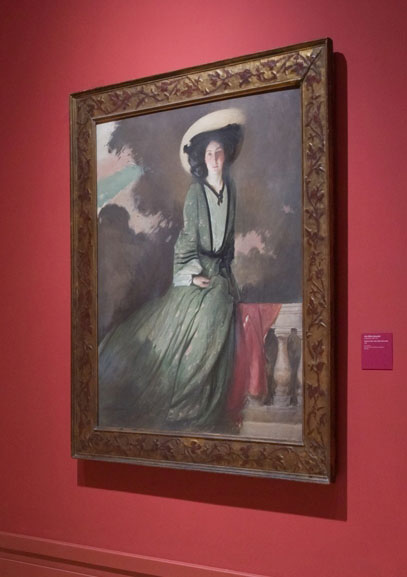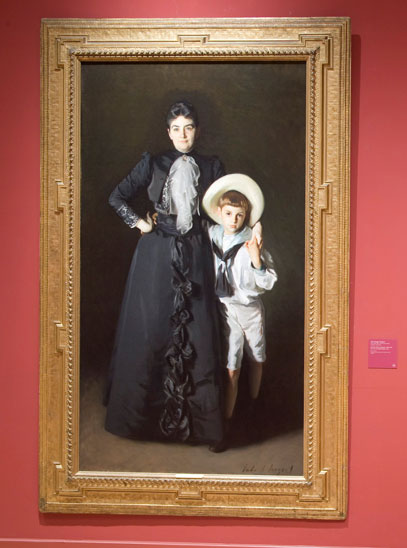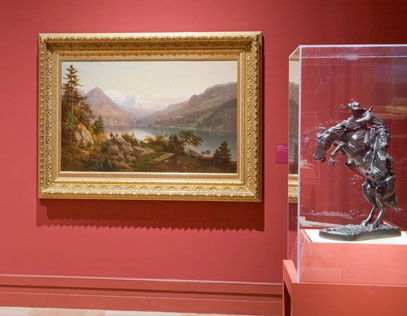Our Ask a Curator series is back for 2010. Do you have a question for any of our curators? Art, collecting, behind-the-scenes tidbits—or anything else you’re curious about? Leave a question in the comments, send us a tweet, or email us and we’ll find a curator to answer.
To kick things off, an anonymous commenter asks: What’s your process for choosing the right frame?
The art of framing is to complement a work of art, not to compete with a painting’s inherent qualities. But a great frame can be a work of art in its own right. When choosing a frame, there are myriad aesthetic considerations to take into account in relation to the art within, such as its material, its color, its profile (shape), and its design, carving, or texture. Consider how the red tones of the low relief vine curving around the burnished gilt frame beautifully pick up on the organic forms, forested setting, dominant green, rose, and brown palette, and linear details in this portrait of the artist’s wife, Mrs. John White Alexander.

John White Alexander, "Portrait of Mrs. John White Alexander," 1902, Gift of Dr. and Mrs. Matthew S. Mickiewicz
For American works created in the mid-twentieth century and earlier (my territory), there is also the very important matter of tradition and history. How was the painting originally framed? Occasionally, paintings retain their magnificent original frames, like the one designed by renowned American architect Stanford White that surrounds the Portrait of Mrs. Edward L. Davis and Her Son, Livingston Davis, painted by John Singer Sargent in 1890.

John Singer Sargent, "Portrait of Mrs. Edward L. Davis and Her Son, Livingston Davis," 1890, Frances and Armand Hammer Purchase Fund
Our California Landscape by William Wendt had originally been installed as an over-mantel painting in a home, so it had no frame at all. LACMA curators worked with our designer and conservator to create a simple frame that would enable the painting to hang in our Arts and Crafts gallery in a context similar to its original one and also give the sense of looking out onto the landscape.
More typically, however, an original frame is lost or unknown, so we research how the painting, or paintings like it, would have been framed when first created or exhibited. Sometimes, however, historically appropriate frames simply don’t look right, and curators seek to improve the overall appearance of the picture by reframing it. But period frames are almost always our starting point.
Museums have a few options for framing historical paintings: they can purchase a period frame, reproduce a period frame based on careful research, retrofit existing period frames for an appropriate work, or work with designers to construct a new frame that complements the historical painting.
For example, Thomas Hill’s Emerald Bay, Lake Tahoe, painted in 1864, was housed in a mediocre frame that did not do justice to this accomplished and art historically important view of the Western landscape. Fortunately, a grand mid-nineteenth-century frame was in the collection and was retrofitted by our objects conservator, Don Menveg, with a new liner to fit the Hill. The reframed painting now has the presence it deserves in our galleries.

Thomas Hill, "Emerald Bay, Lake Tahoe," 1864, William Randolph Hearst Collection

"Emerald Bay, Lake Tahoe," detail



